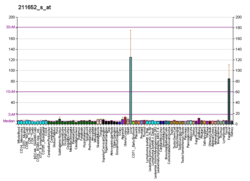Lipopolysaccharide binding protein
Appearance
Lipopolysaccharide binding protein is a protein that in humans is encoded by the LBP gene.[5][6]
LBP is a soluble acute-phase protein that binds to bacterial lipopolysaccharide (or LPS) to elicit immune responses by presenting the LPS to important cell surface pattern recognition receptors called CD14 and TLR4.[7]
Interactions
Lipopolysaccharide-binding protein has been shown to interact with CD14, TLR2, TLR4 and the co-receptor MD-2.[8][9][10]
References
- ^ a b c GRCh38: Ensembl release 89: ENSG00000129988 – Ensembl, May 2017
- ^ a b c GRCm38: Ensembl release 89: ENSMUSG00000016024 – Ensembl, May 2017
- ^ "Human PubMed Reference:". National Center for Biotechnology Information, U.S. National Library of Medicine.
- ^ "Mouse PubMed Reference:". National Center for Biotechnology Information, U.S. National Library of Medicine.
- ^ Gray PW, Corcorran AE, Eddy RL Jr, Byers MG, Shows TB (March 1993). "The genes for the lipopolysaccharide binding protein (LBP) and the bactericidal permeability increasing protein (BPI) are encoded in the same region of human chromosome 20". Genomics. 15 (1): 188–90. doi:10.1006/geno.1993.1030. PMID 8432532.
- ^ Cite error: The named reference
entrezwas invoked but never defined (see the help page). - ^ Muta T, Takeshige K (2001). "Essential roles of CD14 and lipopolysaccharide-binding protein for activation of toll-like receptor (TLR)2 as well as TLR4 Reconstitution of TLR2- and TLR4-activation by distinguishable ligands in LPS preparations". Eur. J. Biochem. 268 (16): 4580–9. doi:10.1046/j.1432-1327.2001.02385.x. PMID 11502220.
- ^ Thomas, Celestine J; Kapoor Mili; Sharma Shilpi; Bausinger Huguette; Zyilan Umit; Lipsker Dan; Hanau Daniel; Surolia Avadhesha (November 2002). "Evidence of a trimolecular complex involving LPS, LPS binding protein and soluble CD14 as an effector of LPS response". FEBS Lett. 531 (2). Netherlands: 184–8. doi:10.1016/S0014-5793(02)03499-3. ISSN 0014-5793. PMID 12417309.
{{cite journal}}: Cite has empty unknown parameters:|laydate=,|laysource=, and|laysummary=(help) - ^ Yu, B; Wright S D (1995). "LPS-dependent interaction of Mac-2-binding protein with immobilized CD14". J. Inflamm. 45 (2). UNITED STATES: 115–25. ISSN 1078-7852. PMID 7583357.
{{cite journal}}: Cite has empty unknown parameters:|laysummary=,|laydate=, and|laysource=(help) - ^ Erridge, C; Pridmore, A; Eley, A; Stewart, J; Poxton, IR (2004). "Lipopolysaccharides of Bacteroides fragilis, Chlamydia trachomatis and Pseudomonas aeruginosa signal via toll-like receptor 2". Journal of Medical Microbiology. 53 (Pt 8): 735–40. doi:10.1099/jmm.0.45598-0. PMID 15272059.
Further reading
External links
- lipopolysaccharide-binding+protein at the U.S. National Library of Medicine Medical Subject Headings (MeSH)
This article incorporates text from the United States National Library of Medicine, which is in the public domain.







